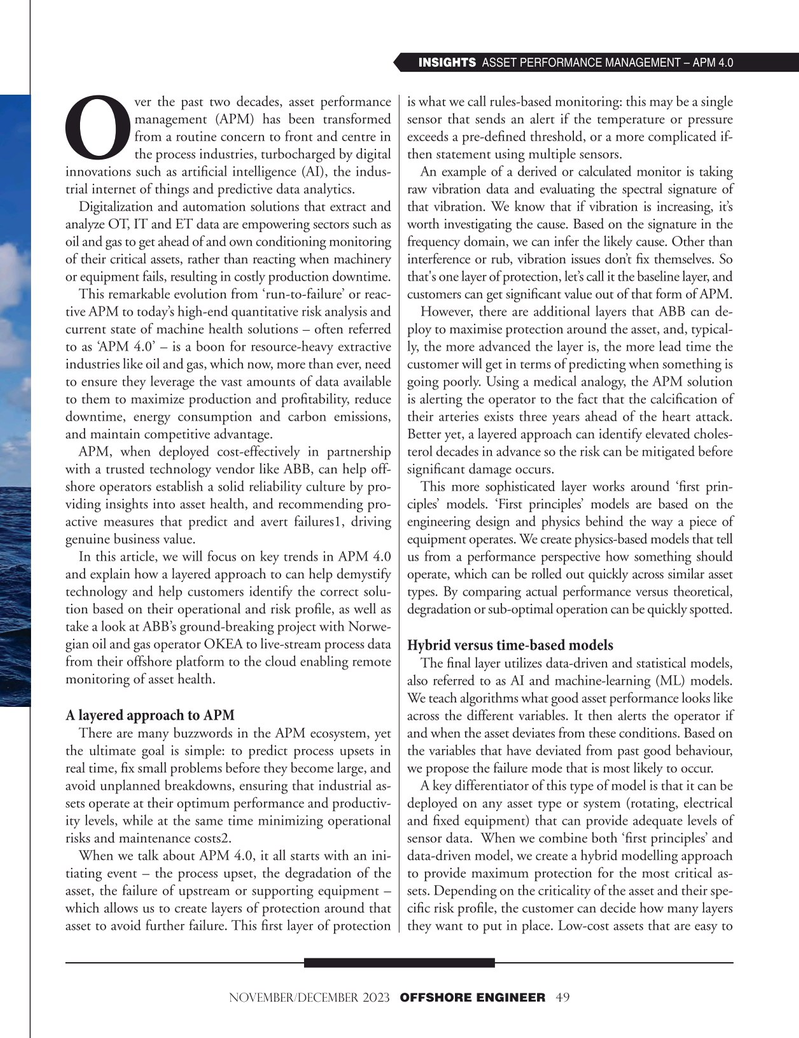
Page 49: of Offshore Engineer Magazine (Nov/Dec 2023)
Read this page in Pdf, Flash or Html5 edition of Nov/Dec 2023 Offshore Engineer Magazine
INSIGHTS ASSET PERFORMANCE MANAGEMENT – APM 4.0 ver the past two decades, asset performance is what we call rules-based monitoring: this may be a single management (APM) has been transformed sensor that sends an alert if the temperature or pressure from a routine concern to front and centre in exceeds a pre-defned threshold, or a more complicated if-
O the process industries, turbocharged by digital then statement using multiple sensors. innovations such as artifcial intelligence (AI), the indus- An example of a derived or calculated monitor is taking trial internet of things and predictive data analytics. raw vibration data and evaluating the spectral signature of
Digitalization and automation solutions that extract and that vibration. We know that if vibration is increasing, it’s analyze OT, IT and ET data are empowering sectors such as worth investigating the cause. Based on the signature in the oil and gas to get ahead of and own conditioning monitoring frequency domain, we can infer the likely cause. Other than of their critical assets, rather than reacting when machinery interference or rub, vibration issues don’t fx themselves. So or equipment fails, resulting in costly production downtime. that's one layer of protection, let’s call it the baseline layer, and
This remarkable evolution from ‘run-to-failure’ or reac- customers can get signifcant value out of that form of APM. tive APM to today’s high-end quantitative risk analysis and However, there are additional layers that ABB can de- current state of machine health solutions – often referred ploy to maximise protection around the asset, and, typical- to as ‘APM 4.0’ – is a boon for resource-heavy extractive ly, the more advanced the layer is, the more lead time the industries like oil and gas, which now, more than ever, need customer will get in terms of predicting when something is to ensure they leverage the vast amounts of data available going poorly. Using a medical analogy, the APM solution to them to maximize production and proftability, reduce is alerting the operator to the fact that the calcifcation of downtime, energy consumption and carbon emissions, their arteries exists three years ahead of the heart attack. and maintain competitive advantage. Better yet, a layered approach can identify elevated choles-
APM, when deployed cost-effectively in partnership terol decades in advance so the risk can be mitigated before with a trusted technology vendor like ABB, can help off- signifcant damage occurs.
shore operators establish a solid reliability culture by pro- This more sophisticated layer works around ‘frst prin- viding insights into asset health, and recommending pro- ciples’ models. ‘First principles’ models are based on the active measures that predict and avert failures1, driving engineering design and physics behind the way a piece of genuine business value. equipment operates. We create physics-based models that tell
In this article, we will focus on key trends in APM 4.0 us from a performance perspective how something should and explain how a layered approach to can help demystify operate, which can be rolled out quickly across similar asset technology and help customers identify the correct solu- types. By comparing actual performance versus theoretical, tion based on their operational and risk profle, as well as degradation or sub-optimal operation can be quickly spotted.
take a look at ABB’s ground-breaking project with Norwe- gian oil and gas operator OKEA to live-stream process data
Hybrid versus time-based models from their offshore platform to the cloud enabling remote
The fnal layer utilizes data-driven and statistical models, monitoring of asset health. also referred to as AI and machine-learning (ML) models.
We teach algorithms what good asset performance looks like
A layered approach to APM across the different variables. It then alerts the operator if
There are many buzzwords in the APM ecosystem, yet and when the asset deviates from these conditions. Based on the ultimate goal is simple: to predict process upsets in the variables that have deviated from past good behaviour, real time, fx small problems before they become large, and we propose the failure mode that is most likely to occur.
avoid unplanned breakdowns, ensuring that industrial as- A key differentiator of this type of model is that it can be sets operate at their optimum performance and productiv- deployed on any asset type or system (rotating, electrical ity levels, while at the same time minimizing operational and fxed equipment) that can provide adequate levels of risks and maintenance costs2. sensor data. When we combine both ‘frst principles’ and
When we talk about APM 4.0, it all starts with an ini- data-driven model, we create a hybrid modelling approach tiating event – the process upset, the degradation of the to provide maximum protection for the most critical as- asset, the failure of upstream or supporting equipment – sets. Depending on the criticality of the asset and their spe- which allows us to create layers of protection around that cifc risk profle, the customer can decide how many layers asset to avoid further failure. This frst layer of protection they want to put in place. Low-cost assets that are easy to november/december 2023 OFFSHORE ENGINEER 49

 48
48

 50
50